⚠️ Previously in Part II
You deciphered the maps of the afterlife, spells of becoming, trials of identity, and the ciphered rites of return. But resurrection is not mere passage. Now comes the test of transfiguration, when Ka, Ba, and Ren ignite as one: the Akh, radiant and eternal.
🌾 Chapter 26: The Field of Reeds, The Mirror of the Soul’s Becoming
“Sekhet-Aaru em ren-a, neferu n ankh.”
“The Field of Reeds in my name, the beauty of eternal life.”
Book of the Dead, Spell 110
After the gates. After the trials. If the soul passes, it enters a place called Sekhet-Aaru, the Field of Reeds. But this is not heaven as reward. It is mirror and harvest.
Sekhet-Aaru appears lush and abundant, an ideal version of Egypt’s fertile lands. There are canals, birdsong, loved ones, and endless fields to cultivate. But these fields are not just crops, they are the soul’s own actions made visible. Your deeds, thoughts, and truths, returned as an environment you must walk.
If you lived in harmony with Ma’at, your field is green and fruitful. If not, it is barren, tangled, strange. This is not judgement by an external god. This is yourself revealed in form.
This is why the Field is not a gift. It is a mirror of coherence. You don’t arrive here through belief, but through frequency. The landscape remembers what you forgot.
“Iu em sekhet, djed netjer nefer.”
“He comes into the field, the god says it is good.”
Pyramid Texts, Utterance 587
Sekhet-Aaru is the world built from your frequency. Not a dream. A result. And in it, you are given time, to learn, to work, to merge with light. It is not the end of the journey. It is the soul in reflection, before final ascent.
Just like the Gnostic aeons form inner worlds, so too does Sekhet-Aaru: a visible reflection of your hidden order. It is the first heaven, not the last.
⚡ TL;DR
- Sekhet-Aaru (Field of Reeds) is the Egyptian “paradise,” but not as reward, it is the reflection of your own actions.
- The soul lives in a self-generated landscape based on alignment with Ma’at.
- It is fertile or barren, beautiful or distorted, depending on the life you lived.
- This realm is not permanent, it is preparatory, contemplative, and transformational.
- The Field of Reeds is the mirror world before the final transfiguration into Akh.
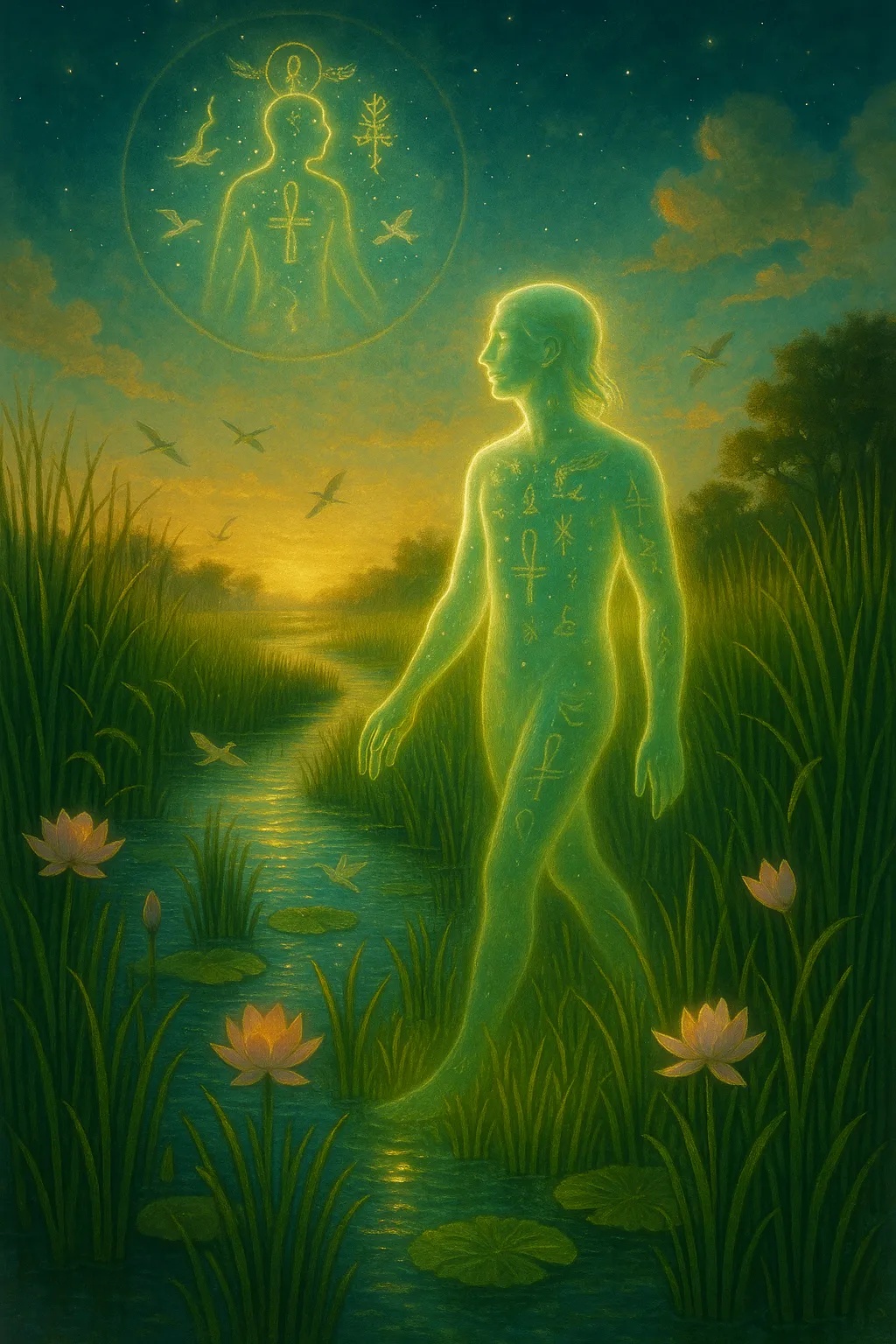
⚖️ Chapter 27: The Weighing of the Heart, Justice Beyond Illusion
“Ib-a em Ma’at, djedu em ankh.”
“My heart is in truth, my words are life.”
Book of the Dead, Spell 30B
Every soul, no matter how radiant, must pass through the Hall of Two Truths. Here, the heart, seat of memory and motive, is placed on a scale. On the other side rests a single feather: the emblem of Ma’at, cosmic truth.
There is no advocate here. No priest. Only the heart and the weightless feather. This is soul science, not divine whim.
This is not a test by doctrine. It is a vibrational measure. The heart must be light, unburdened by deception, greed, or distortion. Not sin in the modern sense, but imbalance. The scales do not lie.
The god Thoth records the verdict. Anubis tends the scale. And if the heart weighs heavier than truth? It is thrown to Ammit, the devourer, and the soul ceases to be.
Egyptologist Jan Assmann describes this not as eternal punishment, but as cosmic annihilation, the soul is unmade, erased from memory, unfit for further becoming.
"Ankh ib em Ma’at, sa netjer em kheper."
“The heart lives in Ma’at, the god becomes through it.”
Temple of Horus, Edfu
This is not cruelty. It is equilibrium enforcement. The soul must resonate with truth to proceed. And if it does, it moves on to become Akh: transfigured, luminous, eternal. But first, the scale must speak.
Gnostics speak of Archons, threshold beings who test the soul’s purity. This is the Egyptian mirror of that gate: not fear, but resonant alignment.
“Khet n ib djed Maat.”
“The deed of the heart is weighed by Ma’at.”
Book of the Dead, Spell 125
Just like the Gnostic aeons form inner worlds, so too does Sekhet-Aaru: a visible reflection of your hidden order. It is the first heaven, not the last.
⚡ TL;DR
- The Weighing of the Heart is a metaphysical judgement, a test of truth, not belief.
- The heart is weighed against the Feather of Ma’at, symbol of universal harmony.
- If the heart is too heavy, the soul is unmade, erased from cosmic memory (see Assmann, 2005).
- This is not divine punishment, but vibrational coherence, only alignment proceeds.
- The process is archetypal, it appears in dreams, initiations, and inner trials.

🗣️ Chapter 28: 42 Judges, 42 Confessions, The Trial of Memory
“N djed khef, n djed netjer.”
“No lies have I spoken, no god have I deceived.”
Book of the Dead, Negative Confession
After the weighing, the soul enters a more intimate court: 42 Neteru, divine aspects of Ma’at, each representing a principle of truth. One by one, they listen as the soul speaks its memory.
This is the Negative Confession. Not a plea for forgiveness, but a statement of alignment. “I have not stolen.” “I have not polluted the waters.” “I have not caused needless pain.”
Each confession is a vibrational check, does your soul resonate with what you speak? If you lie, the echo distorts. If you speak truth, the gate opens.
These 42 principles are not moral laws. They are keys to soul coherence. They test the harmony between thought, word, and deed.
“Djed ib-a em djed ren-a, kheper netjeru em ankh.”
“My heart speaks in my name, the gods become in life.”
Temple of Thoth, Hermopolis
The trial is not external. The judges are not separate. Each one is a facet of your soul, asking: Were you honest with me? Did you remember what we came here for?
⚡ TL;DR
- After the heart is weighed, the soul gives 42 “Negative Confessions”, declarations of moral-spiritual alignment.
- Each statement is directed to a different Neter (divine force), testing one facet of Ma’at.
- These are not pleas for mercy, they are affirmations of memory, integrity, and coherence.
- The 42 Judges mirror the soul, amplifying truth or distortion.
- This is soul science: alignment determines passage.
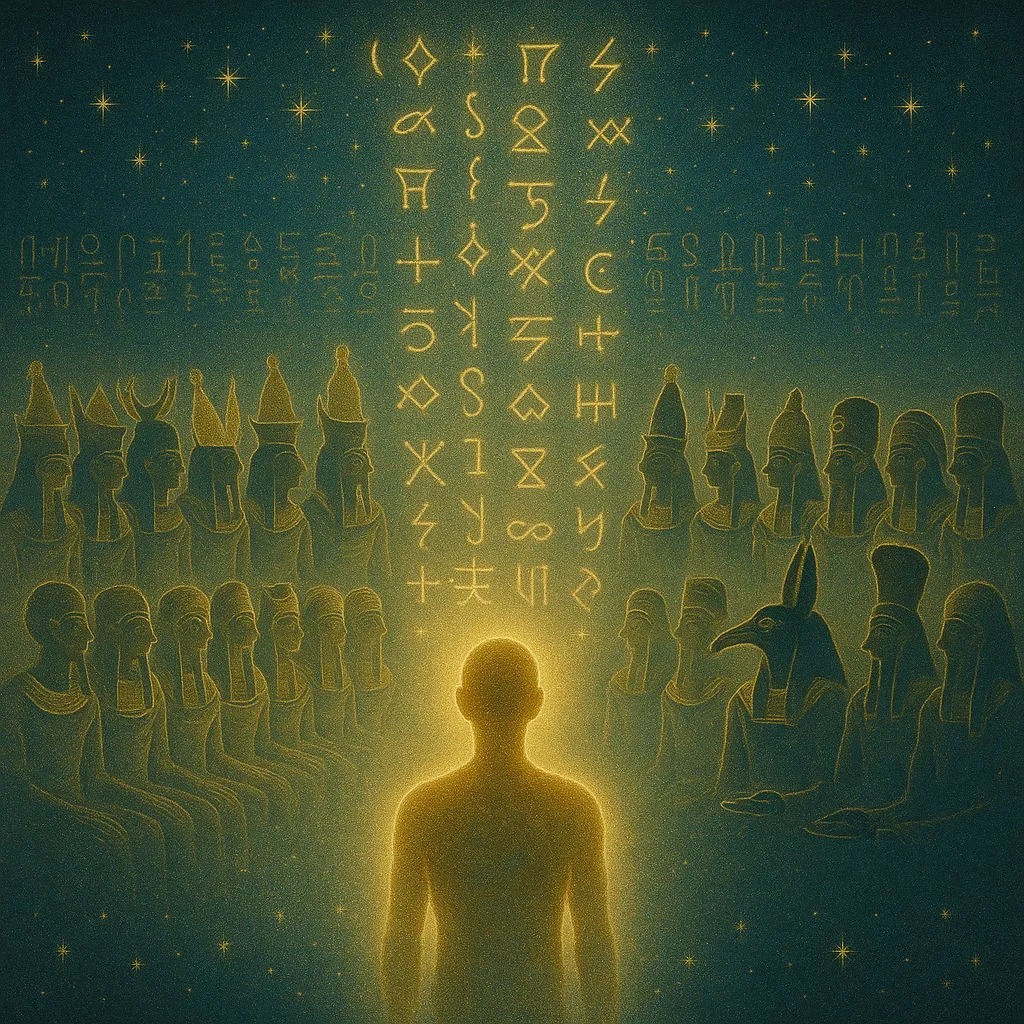
🪶 Chapter 29: The Feather of Ma’at, Balancing Truth and Self
“Ma’at em ren, ankh em djed.”
“Truth in name, life in word.”
Papyrus of Ani, Plate 8
The Feather is not light because it lacks weight. It is light because it has no distortion. In the trial of the soul, the Feather of Ma’at is not just a cosmic measure, it is what you become.
Ma’at is not a goddess to be worshipped. She is a frequency to be matched. Truth, harmony, right order, these are not commandments, but states of being. The Feather is the standard. Your heart must resonate with it.
To live Ma’at is to be transparent in soul. No manipulation. No inner division. Your thought, word, and deed aligned like a beam of sunlight. In this state, you are not weighed, you are weightless.
"Neb Ma’at em ib-a, djed kheperu ankh."
“The Lord of Ma’at is in my heart, becoming speaks life.”
Temple of Karnak, East Wall
This is not about being perfect. It’s about being integral. Unified. Whole. The Feather doesn’t test morality, it tests resonance. And if you match it, the path opens. Because you are already flying.
⚡ TL;DR
- The Feather of Ma’at is the vibrational standard, light, pure, undistorted.
- To “pass” is to live in integrity, thought, word, and deed aligned.
- Ma’at is not belief, it is resonance with truth and harmony.
- The Feather is the mirror of your essence. The lighter you are, the further you go.
- When the soul becomes Ma’at, it needs no wings. It is the flight itself.
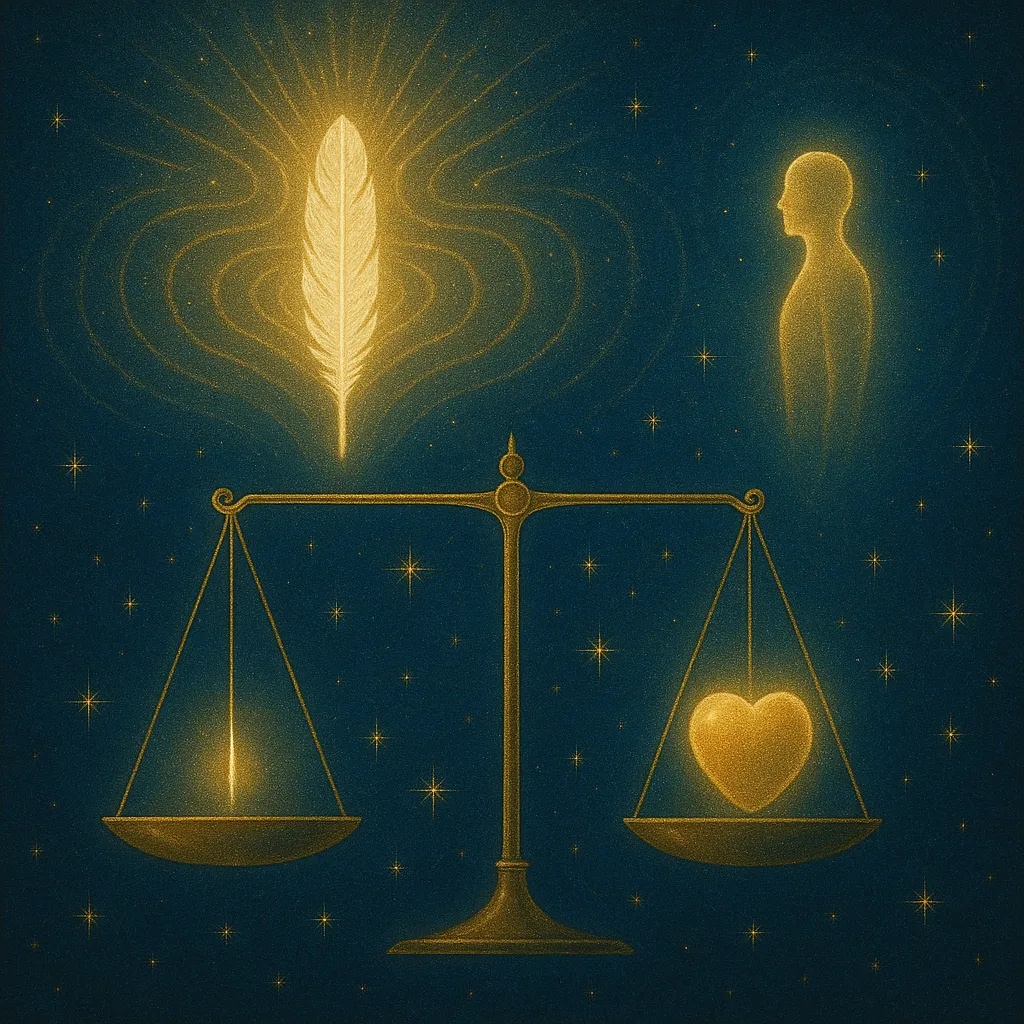
🐊 Chapter 30: The Devourer, What Happens When You Fail
“Ammit em djed, kheperu sesh.”
“Devourer in speech, the forms are erased.”
Papyrus of Hunefer
She waits beside the scale, part crocodile, part lion, part hippopotamus. She is Ammit, “She Who Swallows the Dead.”
But this is not damnation. This is erasure. A soul whose heart is too heavy, too false, too fragmented, is not punished. It is unwritten. It becomes food for Ammit, not in cruelty, but in unfitness for further becoming.
To be devoured is to fail the resonance test. The heart cannot ascend. The body is preserved, the name forgotten. You do not burn. You simply vanish, like a dream that forgets itself.
Ammit is not evil. She is equilibrium. The final safeguard. The memory cleanser of the cosmos. The one who ensures that only coherent light continues.
“N djed kheper, ammit em ankh.”
“No becoming is spoken, devouring is the only life.”
Coffin Texts, Spell 157
This is not to scare you. It is to clarify the stakes. The soul is not saved by mercy, it is sustained by memory, alignment, and truth. Only what is true can endure. The rest is unmade.
⚡ TL;DR
- Ammit is the devourer of unworthy souls, not out of malice, but function.
- If a soul’s heart is heavier than Ma’at, it is erased, forgotten by the cosmic memory.
- This is not eternal torment, it is annihilation through dissonance.
- Egyptian judgement is based on coherence, not religion or sin.
- Only the soul that aligns may ascend. The rest dissolve like forgotten dreams.

🌟 Chapter 31: Becoming the Akh, The Soul Transfigured
“Akh em djed, kheperu em sekhem.”
“Akh in word, becoming in power.”
Pyramid Texts, Utterance 422
The trials are passed. The heart is light. The soul remembers. And now, it transfigures.
The Akh is not simply a phase of the soul, it is a state of becoming. A fusion of memory, name, truth, and radiance. The Ba and Ka rejoin. The name shines in the pages. The soul becomes starfire.
To become Akh is to become immortal, radiant, effective. Not just to survive death, but to master it. You rise not as shadow or echo, but as a being of light, who may dwell with the gods, or guide others.
The Akh can appear. The Akh can bless. The Akh can shape history, dreams, and lives. It is the eternal self, conscious, coherent, and cosmic.
“Djed ren-a em akhet, kheper netjer em khetem.”
“My name is spoken in the horizon, I become a god in the seal.”
Temple of Luxor, Akh Chapel
Gnostic echoes call this the divine spark. Egyptian wisdom calls it the Akh. But both agree: You are not your body. You are the fire that remembers.
⚡ TL;DR
- The Akh is the final form of the soul, luminous, eternal, divinely effective.
- It arises when the soul passes all trials with coherence and memory intact.
- The Akh is immortal, able to dwell among the gods or act in the world.
- This is not metaphor, it is soul-technology. Gnosis through becoming.
- To become Akh is to awaken as light, no longer bound by illusion, fear, or time.

🌌 Chapter 32: The Star Map, Returning to the Constellations
“Sopdet em kheperu, ren em pet.”
“Sirius becomes in becoming, the name is in the sky.”
Pyramid Texts, Utterance 302
Every Akh needs a destination. For the Egyptians, it was not vague paradise, it was the stars.
The ancients mapped specific constellations as destinations for the awakened soul. Sirius (Sopdet), Orion (Sah), and the circumpolar stars, known as the Imperishables, were cited again and again in funerary texts as the places where the Akh shall dwell.
In Pyramid Texts, Utterance 882, the soul declares: “May you ascend to the sky among the stars… may you sit among the Imperishables and never die again.”
Why the stars? Because they are fixed, eternal, luminous. They are memory in the heavens. And to rise among them is to be remembered, to continue as light.
The tombs were aligned. The pyramids encoded their angles. Every symbol, every spell, every shaft, a cosmic GPS for the Akh.
“Akhu em pet, kheperu em sesh.”
“The shining ones in the sky, becoming through writing.”
Temple of Dendera, Star Chamber
This was not primitive belief. It was resonant architecture. A soul that remembered its name, passed its trial, and transfigured into Akh, could then rejoin the Source through the stars.
⚡ TL;DR
- The Akh does not wander, it ascends to mapped constellations, especially Sirius and Orion.
- Pyramid Texts explicitly describe this stellar destination (e.g. Utterance 882).
- These stars represent eternal, radiant consciousness, the divine “sky-beings.”
- Egyptian architecture and texts encoded stellar coordinates for the soul.
- This was a return to cosmic Source, not escape. The stars are not destination only, they are your origin.
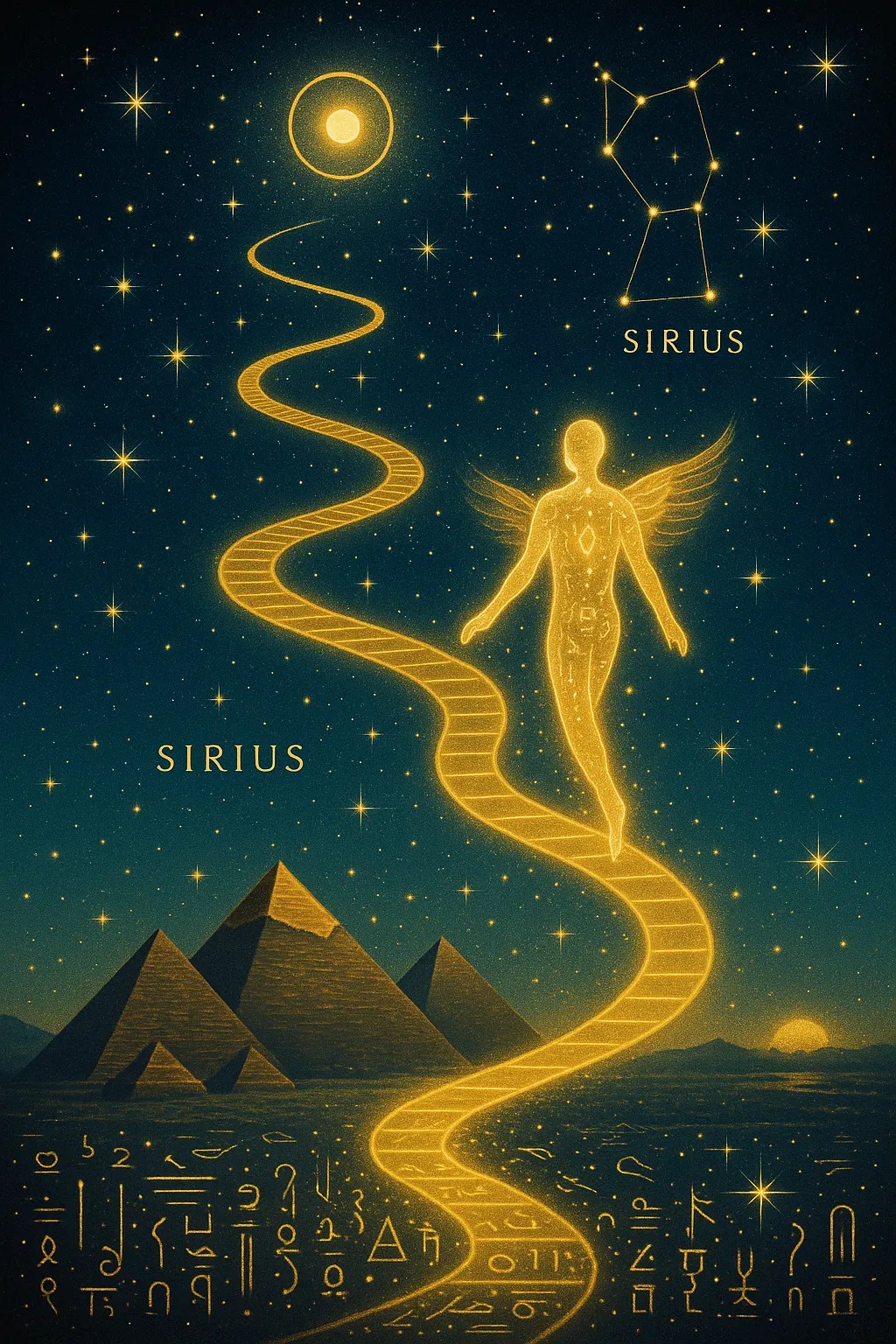
🔥 Chapter 33: The Role of the Ka, Fuel, Offering, Flame
“Ka em ankh, sekhem em djed.”
“Ka is life, power in speech.”
Pyramid Texts, Utterance 215
In Egyptian soul anatomy, the Ka is the double, the vital essence, the energetic body. Unlike the Ba, which moves, or the Akh, which ascends, the Ka is the fire within. It is the soul’s flame.
The Ka must be nourished. This is why offerings were made, bread, wine, incense. Not to appease, but to feed. The Ka feeds on energy, memory, and presence. A starved Ka dims the whole being. A strong Ka fuels the resurrection engine.
The tomb becomes the Ka’s temple. Every hieroglyph carved, every item placed, food for the Ka. And the more coherent the Ka, the more radiant the Akh becomes.
“Djed n Ka-a, ankh em ren.”
“Words to my Ka, life in name.”
Coffin Texts, Spell 103
Today, your Ka is still with you, your will, your breath, your subtle body. Strengthen it through ritual, memory, offering, and alignment. The Ka is your fire. The Akh is your flame made divine.
⚡ TL;DR
- The Ka is the life-force double, an energetic, immortal body requiring nourishment.
- Offerings were not symbolic, they were metaphysical food for the Ka’s vitality.
- A strong Ka fuels the transformation into Akh. A weak Ka weakens memory and ascent.
- Modern Ka practices include breathwork, sacred food, memory rituals, and offerings.
- Ka is the inner altar. Feed it, and your fire will rise.
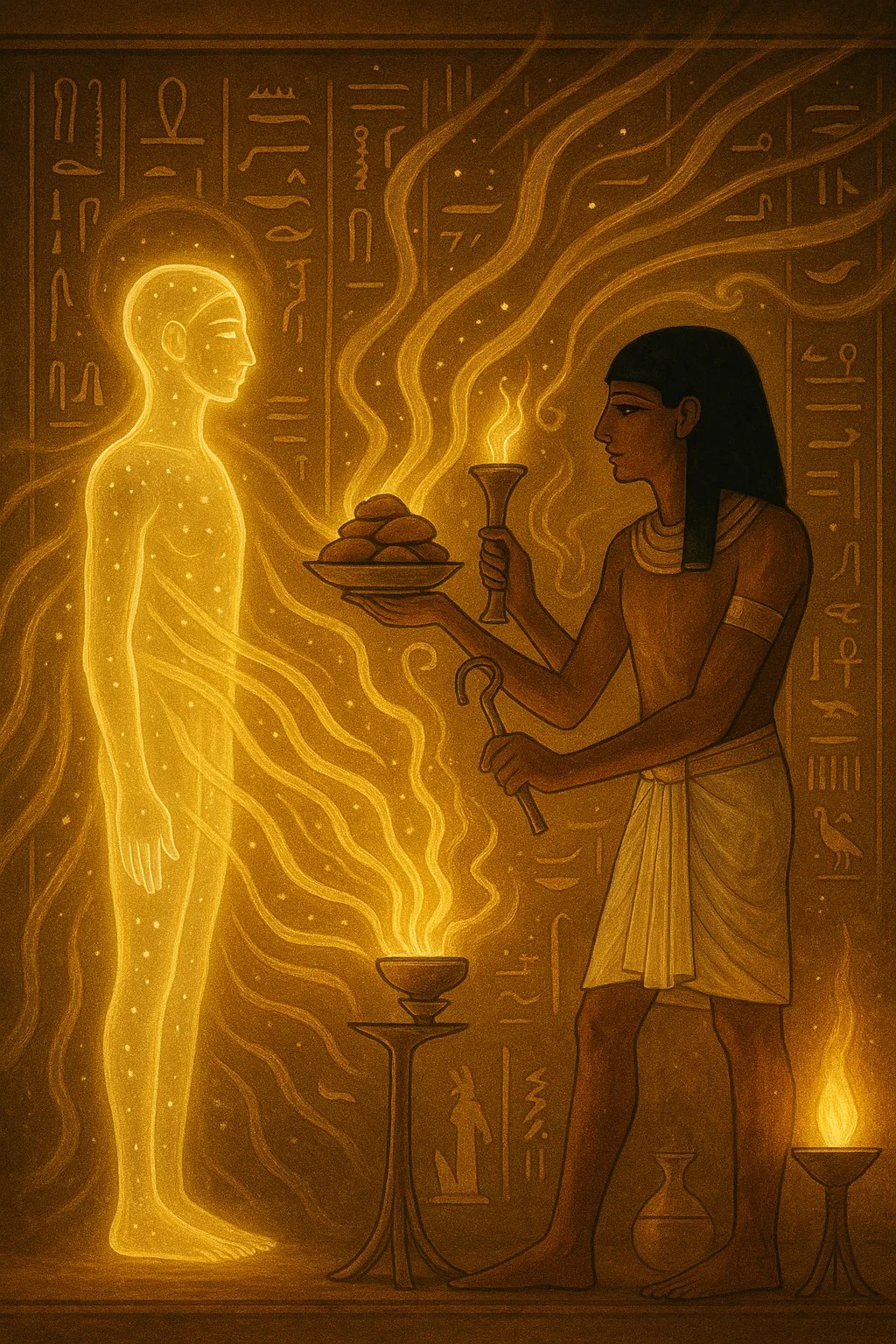
🗝️ Chapter 34: Final Resurrection, When the Name Is Eternal
“Ren-a em djed, akh-a em pet.”
“My name is spoken, my Akh is in the sky.”
Book of the Dead, Spell 25
What is resurrection, really?
It is not revival of the body. It is the preservation of memory, the Name carried through death, trial, and fire. When your Ren remains spoken, your light continues.
Egyptian resurrection is not resuscitation, it is transformation. The soul becomes Akh, the Ka is fed, and the Ren, the vibrational signature of the Self, is sealed in the pages of the stars.
To achieve resurrection is to write yourself into the structure of reality. To become known by the gods, not for deeds or titles, but for essence. You become a line in the sky, a note in the eternal chord.
“Ren djeser, kheperu em ankh netjer.”
“The sacred name, becoming in divine life.”
Tomb of Seti I
The highest resurrection is not granted, it is earned through coherence. When you speak truth, nourish your Ka, remember your path, and shine as Akh, your name becomes a living word in the fabric of the cosmos.
⚡ TL;DR
- Resurrection in Egyptian thought is soul-transformation, not physical reanimation.
- The Ren (name) is the carrier of soul-essence, if remembered, the soul endures.
- Final resurrection occurs when the name is sealed in truth and light, becoming part of the divine order.
- This is achieved through alignment with Ma’at, radiant Akhhood, and soul integrity.
- You do not resurrect by force. You resurrect by resonance.
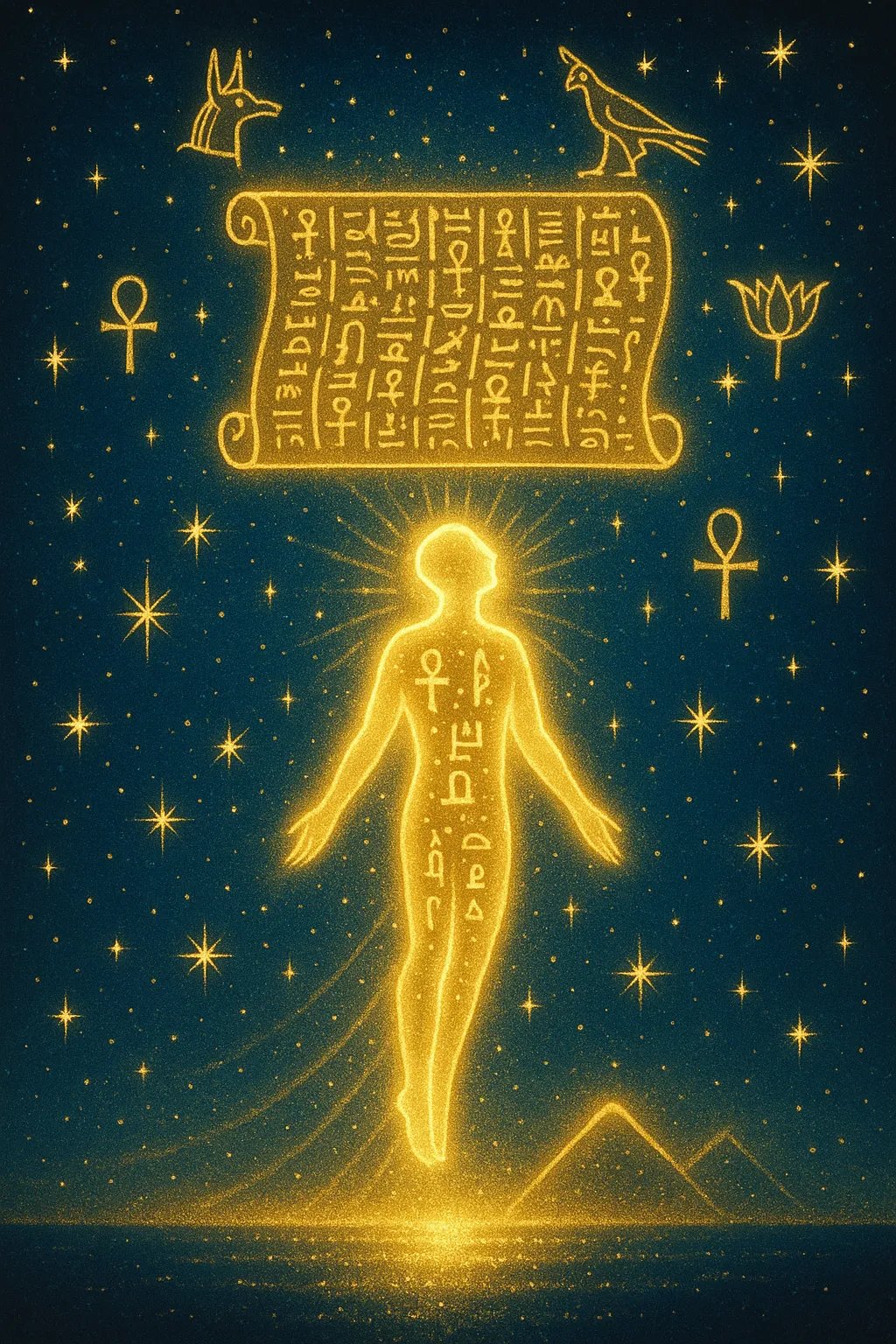
🌀 Chapter 35: Gnostic Reflections, Memory, Light & the Divine Self
“If you bring forth what is within you, what you bring forth will save you. If you do not bring forth what is within you, what you do not bring forth will destroy you.”
Gospel of Thomas, Logion 70
The Egyptian Akh and the Gnostic Divine Spark speak of the same inner technology: a soul that remembers, purifies, and returns.
These are not doctrinal equivalents, they are archetypal mirrors. Both traditions offer symbolic maps of the immortal Self: one as starfire, one as divine seed. Each path names the same secret: You carry what the gods are looking for.
Both teach that death is not an end. It is a proving ground, a mirror, a gate. And the one who passes is not the ego or the mind. It is the truthful essence within, called Ren, Akh, or Spark.
The Archons of the Gnostics, like the Gatekeepers of the Du”st, test the soul. They tempt it with fear, illusion, and false light. But the one who knows their Name, who speaks with coherence, cannot be detained.
Whether crossing the Bardo, the Astral Threshold, or the Field of Reeds, the Gnostic path and the Egyptian path converge on this: You are not saved. You are revealed.
“Let him who seeks, not cease seeking until he finds. When he finds, he will be troubled. When he is troubled, he will marvel. And he will reign over all.”
Gospel of Thomas, Logion 2
The Akh is your future memory. The Spark is your hidden self. And resurrection is the moment you remember who you've always been.
⚡ TL;DR
- The Akh and the Gnostic Divine Spark describe the same core reality, the awakened, immortal Self.
- These parallels are symbolic archetypes, not one—to—one doctrines.
- Both traditions speak of trials after death, not punishment, but purification.
- Naming, remembering, and aligning are the true tools of liberation.
- The true resurrection is when light and memory unite, and you become the name you were always meant to speak.
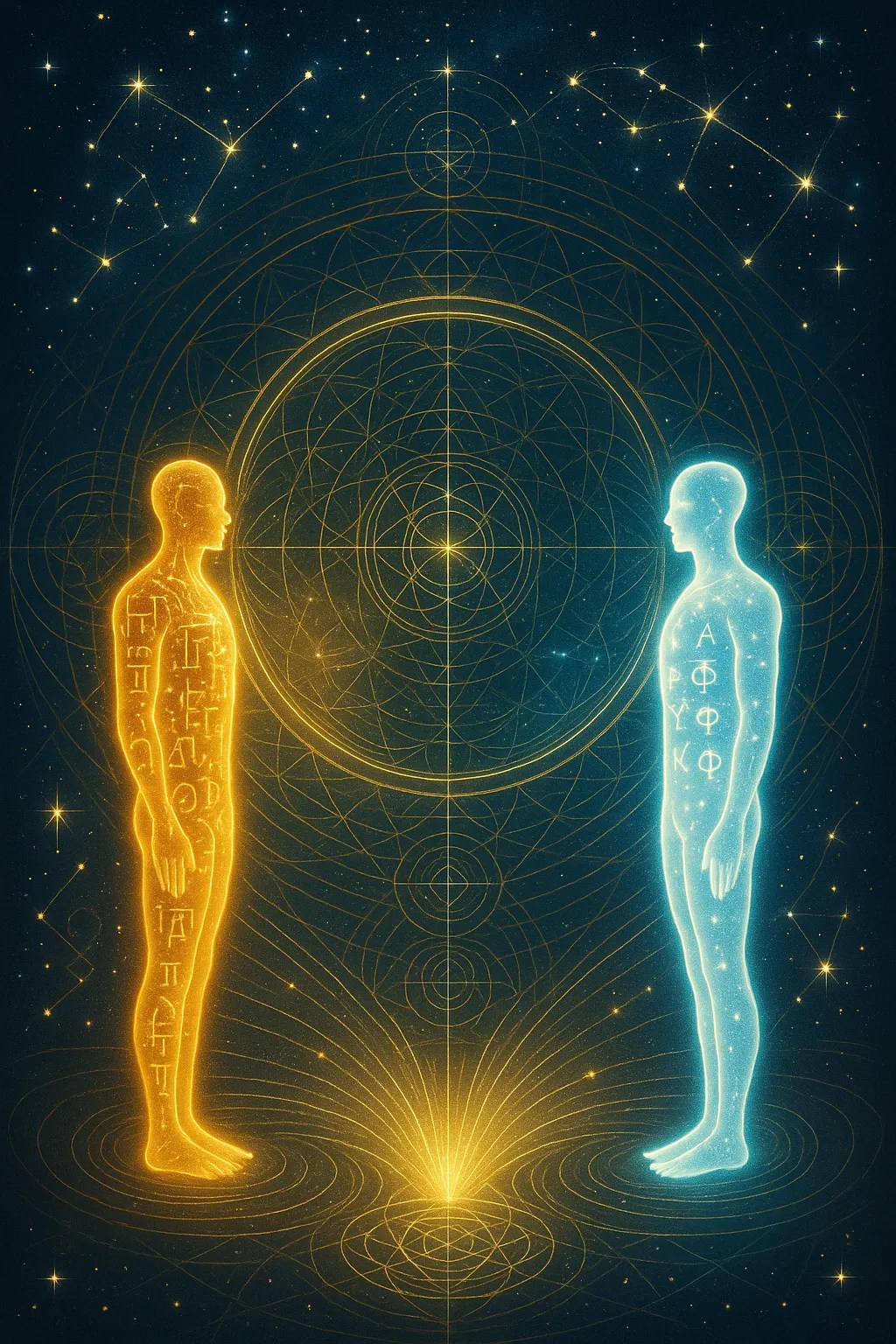
🛠️ Practicing the Egyptian Mysteries
Resurrection does not begin in the tomb. It begins in your choices, your memory, your offerings. These practices awaken the Akh, and prepare the soul to pass the Scales:
- Feather of Ma’at Reflection
Each night, place your hand on your heart. Whisper: “Was I light today?” Recall moments of truth, harmony, or error. Offer a silent vow for balance. - Ka Offering Journal
For 21 days, write one energy gift you gave, a meal, a smile, a hard truth. Title each entry:Date | Gift | Intent | Afterglow. These feed your subtle body. - Name Invocation
Speak your full name aloud each morning. See it rise in golden light. Say: “This name will not be forgotten.” Align with it. Live by it.
To walk as Akh is to remember. To weigh lightly. To live now as if you had already passed through death, radiant, upright, eternal.
🎨 Creative Prompt
Write a poem, draw a glyph, or design a symbol that represents your soul’s journey through the Duat. What form would your Akh take? What truth would your heart reveal before the Scales?
🗣️ What spark are you reigniting?
You’ve walked through illusion and shadow — now speak from your own flame.
What does liberation mean to a soul that remembers?
- What illusions still whisper your name?
- How does memory become freedom?
- Can truth survive comfort?
Share your reflections using #TheGnosticKey and tag @thegnostickey.
🧠 Quiz
Can you see through the veil of III?
📖 Glossary
Decode the symbols of resurrection — where heart, name, and light converge.
- Akh
- The radiant, immortal form of the soul — a union of Ka, Ba, and Ren transfigured into divine light.
- Field of Reeds (Sekhet-Aaru)
- The paradisiacal realm reflecting the soul’s deeds and harmony with Ma’at, a mirror world before final ascent.
- Feather of Ma’at
- The metaphysical standard of truth and balance, used to weigh the heart in the Hall of Two Truths.
- Ren
- The true name of the soul — a vibrational signature which, when remembered, preserves identity across lifetimes and realms.
- Ka
- The vital essence or energetic double of a person, nourished by offerings and prayer to sustain strength beyond death.
- Ammit
- The Devourer — a hybrid guardian who erases unworthy souls whose hearts outweigh Ma’at’s feather.
- Negative Confession
- Forty-two declarations of innocence recited before divine judges, affirming alignment with Ma’at’s cosmic law.
- Imperishables
- The circumpolar stars that never set, representing the eternal dwelling of the perfected Akh in the heavens.